BAFA © 2010. All material here is copyrighted. See conditions above. |
Annabel Knight
playwright, actress, U.K.
|
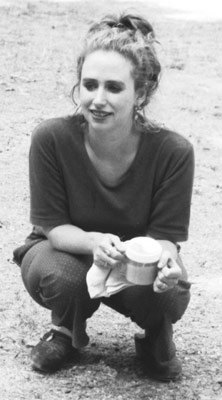
Annabel Knight, 1994.
|
Annabel Knight studied drama at the University of Kent and has worked in theatre as a writer and performer. In recent years she has been actively involved in setting up and teaching children's drama workshops. She is currently working on sitcom projects for British and American television.
Excerpts from an interview in March 1993
with Sonja van Kerkhoff
My theatre career has its roots in ballet. I did my first ballet performance at the age of 3. Love for ballet and the performing arts then gave rise to a love for theatre, as I had a private drama teacher between the ages of 13 and 17. I took the London Academy of Drama and Music examinations, while enjoying long stints with the Wirral Youth Theatre, playing roles such as Sandy in the musical 'Grease', Nina in Chekov's 'The Seagull' and Aunt Em in the 'Wizard of Oz'.
All good fun, and this led me to doing a four year degree in practical and theoretical drama at Kent University. Their approach was more experimental than other universities and we ended up with a thorough grounding in theatre from Isben, Stanislavski, Brecht, to Jerzy Grototowski.
|
Grototowski, a Polish theatre practioner who founded the 'theatre laboratory' in Warsaw was especially interesting for me. His approach was acting as a transformation, is only possible if you are able to let yourself go and be completely honest with yourself in the work. An apt philosophy in a time when actors were prone to hiding themselves behind trickery.
I then joined 'Kent Performance', a theatre company based in south-east England for two years, working full-time acting, directing, and writing 'conventional' plays. It was a valuable experience, but the most rewarding work was when I opened up a branch of the company that dealt specifically with the elderly and the mentally handicapped. Plays were formulated for entertainment and for therapy and toured in special homes, sometimes with us doing up to four shows a day.
This punishing schedule was extremely uplifting because it taught me that anyone could be creative, and that no matter how weakened one's mental facilities might be, we can still use movement, imagination and emotion to express an idea powerfully. A lot of this work was also very moving and taught me something of the human spirit. I've often considered this as some of the most
Bahá´í work that I've ever been engaged in.
In 1991 with the opening up of Eastern Europe, I had made plans to pioneer to Romania, but the amorous clamourings of a certain Bahá´í pioneer living in Bratislava at the time, persuaded me to fly to Prague in November 1991 and to take part in a production organized by the Music, Art and Drama committee of the Bahá´ís of Czechoslovakia. The piece was a dramatic presentation of the life of the poet Khalil Gibran, including his relationship with 'Abdul-Bahá and Juliet Thompson (a Bahá´í and painter living in New York city).
Despite the lamentable and all too familiar format of a group of Bahá´ís simply not having enough time to rehearse, the piece gained momentum with each performance after a less than heartening opening in Bratislava. It went on to tour sucessfully in the main towns and cities of the rest of the country.
After marrying Omid Djalili in Bratislava in 1992, we pioneered to Trnava and resumed work with IN-Theatre, a theatre company (with a sympathy for the avant-garde) that Omid set up in 1990 with the well known Slovak dramaturgist, writer and producer, Julius Gajds. The company had done three productions before I joined and participated in their fourth. This was 'The Chairs' by the French/Romanian playwright Eugene Ionesco, known as one of the founders of the Theatre of the Absurd. The piece was well received, particularly since his work was forbidden before the revolution in '89. The style also proved to be refreshing for the Czech and Slovak audiences as it involved bizarre acting styles, showing truth by exaggeration and the use of an interesting surreal convention by making all subsidary characters invisible.
At the moment Omid and I are working on a piece for the Edinburgh Festival which deals predominantly with the 19th century Bahá´í, Lua Getsinger and the great millenial expectations in her day. It is heavily styllized and incorporates live rythmic congas, which should give it a raw edge.
Theatre is not only a means of self-transcendence or transformation for the actor but also a means for education and instruction. We want to aim for excellence and to avoid amateurish dramatizations of early Bahá´í history. This will become easier the more it is done and when done with a great variety of experimention.
Excerpts from the BAFA newsletter, March 1993, Page 3.
|
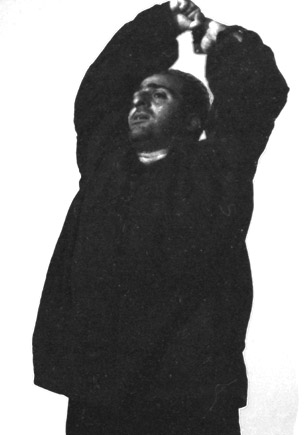 A Strange Bit of History
A Strange Bit of History, written by Annabel Knight. Performed by Omid Djalili, at the 1994 Dutch Bahá´í International Summer School at de Poort, The Netherlands.
Photo: Sonja van Kerkhoff.
|
A Strange Bit of
History is a solo performance by Omid Djalili, written and directed by
Annabel Knight, which was performed at the Dutch Bahá´í International Summer
School in August 1994.
Annabel Knight, living in the Czech Republic, talks to Sonja van Kerkhoff
SvK: Let's start with the poems that are recited by the poet in the play.
AK:
When I was 16 or 17, I wrote this adolescent self-righteous type of poetry, while I was searching for a spiritual truth that I felt was in the world (and later I found this to be the Bahá´í Faith). The poetry seemed just right for the new age Merseyside poet character (A group of poets performing around Liverpool in the 1960's and 70's) who is earnestly searching and feeling the forces of the world. This character perceives something in the world, and this is expressed by the content of his poems, but ironically, his delivery of this poetry is as if he alone has the key to the universe.
|
It is, in a sense, how we all feel as adolescents, where we feel that we are the only ones who can perceive the truth and are the only ones to save the world. We can laugh at this character in particular because he delivers his poems with a fundamental fervour.
The play exists in four separate worlds. One is the world of this new age
Merseyside poet who delivers his poems at some public event in the
twentieth century, and he serves as a kind of link between all the other
worlds which are in the nineteenth century.
The second world is that of
the Egyptian camel driver who, after having a dream about a mysterious
figure, makes a journey through the desert to Persia and meets an
executioner, sees Bahá'u'lláh and is eventually killed.
The third world is
that of the executioner who is executing all these Bábis and describes his
confused feelings about doing this.
And the fourth world is set in
Victorian England and is centered around an Edward Granville Browne type
figure and the Victorian society that he mingled in.
|
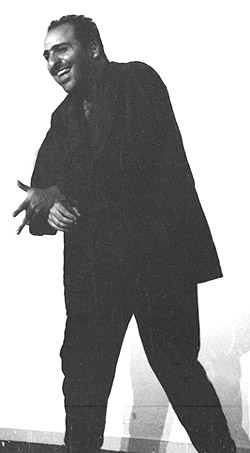 A Strange Bit of History A Strange Bit of History, written by Annabel Knight. Performed by Omid Djalili, at the 1994 Dutch Bahá´í International Summer School at de Poort, The Netherlands.
|

A Strange Bit of History, written by Annabel Knight. Performed by Omid Djalili, in 1994. |
The play jumps around
all these characters with the character of the poet serving as a link
between them all, as he recites poem after poem. Although transformation
is hinted at, no real transformation occurs to the characters. The
executioner doesn't transform from a baddie to a goodie, even at the climax
of the play when he experiences some obvious sense of spirituality on
seeing the face of The Prisoner, as Bahá'u'lláh is called. The affect this
has on this man's life is left as an open question. I wanted the affect
to be ambiguous.
|
SvK: A strength in the play is the use of metaphor and suggestion.
There are a lot of short sharp phrases that reverberate off each other, and
in doing so evoke many levels of interpretation. It is as if the phrases
flit from one world to another just as the characters flit back and forth
during the play, which Omid carries across very convincingly. The play is
also striking in that there are so few accessories on the stage. There is
just Omid clad in black, and the bongos and slide projections that were
used occasionally. Why did you use bongos in particular?
AK: The main reason this is so minimal was that we were asked to create
this play within a very short period of time. I was pregnant and we were
moving a lot and so out of necessity the piece had to be very simple and we
chose things that we knew we could do easily.
I couldn't perform because I
had just given birth, and so Omid would perform solo, and he could already
play the bongos. I like simplicity in theatre as long as there is more
than just words, and as long as the simplicity is not a limitation.
SvK: What was gripping for the audience was that we entered into
semi-darkness, to sit in a semi-circle in silence waiting for an event,
knowing already from the instructions that no one was allowed to leave
until it was finished and that small children had been asked not to attend.
The instructions alone gave a sense of expectation that already made this
feel like a piece of real theatre rather than the usual 'entertainment'
performed at a Bahá´í summer school.
AK: Well, the instructions were out of necessity again, because our
experience has been that Bahá´ís are generally not good audience members.
While I am for having children attend events, I wouldn't like to have my
child present to disturb a performer or a performance. It is very
difficult to concentrate on stage if you then have to worry about children
moving around in the same space as well, and the same as when people are
continually moving around. And my experience has been that non-Bahá´í
audiences are more respectful of theatre and perhaps more accustomed to a
professional theatre atmosphere.
SvK: Well, it is certain that the silences in the play would not have
worked if there had not been silence and we certainly would not have been
so gripped by intensity of the drama if people had been moving chairs. As
an audience member, I appeciated the instructions that were sent out to
everyone earlier in the day so that people not accustomed to attending the
theatre knew what the expectations were and did not inadvertently disturb
the piece for others.
You mentioned that parts of the play were written some years ago. Could
you talk about some of the elements behind the contents of the play itself?
AK: Well, yes, I accidentally came across these poems from my adolescence
and found them hilarious because of their obsessiveness about spirituality.
But they are a way of laughing at myself too, because I find there's
always something so pompous about the term "playwrite" or "playwriter" and
so inserting some bits from my teenage diaries was a way to address this as
well. It was also amusing to remember how I used to be so intense, which
must have seemed ridiculous to my parents, such as shutting myself in my
room to listen to Tibetan music which must have sounded like crashing
cutlery. And this stage where you are so intense and take yourself so
seriously, is a stage that many people don't grow out of which can be
particularly worrying in a religion. So, I used these poems to make fun of
these various situations while using poems which are nevertheless sincere
and pure because they came from a genuine yearning. The humour is because
of the context they are placed in -on a stage within a stage. And my aim
is to stop people, artists especially, from taking themselves so seriously.
|
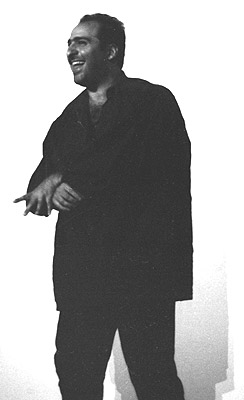 A Strange Bit of History A Strange Bit of History, written by Annabel Knight. Performed by Omid Djalili at the Dutch International Summer School, 1994.
Photo: Sonja van Kerkhoff. |
SvK: I found it more evocative that Omid didn't change costume but just
his pose when he assumed the role of another character, than if he'd done
it more literally. Could you also talk a little about the use of
abstraction which the script reflects.
AK: Well, that's what it's all about: magic. To allow people's
imaginations to run more freely. If you keep it simple, then the "inner"
agenda is easier to access. If things are defined too much then it is
harder for people to use their imagination in interpreting either for
themselves or for other levels of meaning within a given performance or
script. Someone has suggested making a film of this piece incorporating
accessories such as Victorian costume and a camel, etc., and perhaps for
film this would be suitable, but I didn't want to do this because my main
purpose is to create a sense of magic. And for me this is easiest to
achieve through theatre than through any other medium.
SvK: The first character we saw in the semi-darkness was the executioner
who spoke in gushes between hammering at the bongos, who for me was the
main character because he was so clearly defined as someone who's job was
to execute prisoners and who later was fighting with his conscience about
doing this to the Bábis.
The shy Victorian daughter emerges as a strong
character as well because she is the only one of the Victorians who listens
to Browne's message. However, she doesn't appear as dominant as the
executioner because, in these parts, Omid is constantly changing character
whereas the executioner is a solo character who generally talks to the
audience or himself. I found that many of the Bahá'ís I met after the
performance were upset by the play and in particular didn't feel
comfortable about the executioner. |
AK: In my limited experience of theatre incorporating Bahá´í history, there
has always been a character who does not recant or a martyr is portrayed,
and the plays that I have seen tend towards a sentimental climax. Of
course it is valid to be uplifted by the martyrs but I think there are many
ways to show suffering and real commitment to your faith. I felt it was
stronger to present these elements from the viewpoint of someone who was
doing the persecuting rather than the victim because it is not very
interesting to show someone in a transported state of ecstacy. I felt it
was interesting to explore the doubts, the misgivings and hatred that such
a character could have about his position as a persecutor.
SvK: In using an "outsider" you not only had greater freedom to explore
these types of emotions but it also made the person: the persecutor
accessible as a human with feelings. For me it is also easier to identify
with a fallible and highly emotional character than a pure martyr-like
character. I could imagine that the feelings and questions that the
executioner asked himself could just as easily come from the mouth of a
Bábí character, except that the moment when the executioner experiences on
seeing The Prisoner, is heightened in contrast to his statements of hatred
earlier. The character also came across as a complex man because he does
not progress simply to a transformed man but argues with himself. He
thinks differently to how he acts and while one minute it seems as if he
would join the Babis, it seems as if he hates them more than ever in the
next. It is the unexpected and his changing emotions which make the
character a compelling one.
To me, you have reinterpreted a slice of what could be Babi history rather than retold what is recorded as a piece of Bábí history. It seems that A Strange Bit of History is more about ideas of particular worlds
that retelling particular events. |
AK: Yes, and it is likely that during the Bábí times that there were Bábís
who recanted their faith and who were not very heroic, and who ran away and
these are things that I'd like to address in my play. I wanted to deal
with the difficulties about faith, about choosing to believe or not, and
being a Bábí , which are issues pertinent to today. I even find that
concentration on heroism can be disempowering, as there are few of us who
could meet such a standard, nor in some ways, is this type of heroism an
appropriate mode of behaviour for many of us today.
I chose the Edward Granville Browne character because I wanted a Victorian
and he was an obvious choice. Someone who also witnessed some of the
executions. Perhaps I was being too literal by choosing a character so
close to a real one. However, what I really wanted to show in these scenes
was the Victoriam hypocrisy, where these people pretend and act so
artificially in contrast to the direct emotions of the two Oriental
characters. Victorian conversation was quite easy for me to write but
perhaps that's because I have studied Victorian literature and have read a
lot of Victorian novels.
|
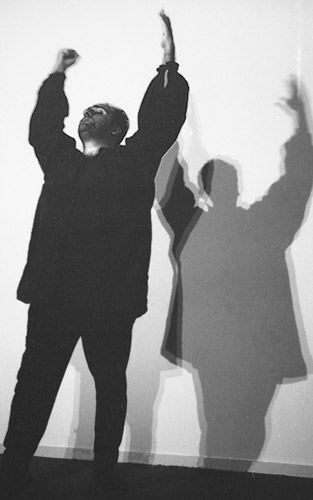 A Strange Bit of History A Strange Bit of History, written by Annabel Knight. Performed by Omid Djalili, at the Dutch International Summer School, 1994.
Photos: Sonja van Kerkhoff.
|
The conversations that you read in these novels
is the kind of feeling that I wanted to engender into the script. As for
other characters, I didn't do much research. I just read a few books about
the history of that time. A lot of phrases came from improvising. I'd
give Omid a theme to improvise around or ask him to say certain things, and
a lot of ideas and lines grew out of these exchanges. So the script grew
out of a mixture of devising and reading history.
SvK:The slides seemed to introduce the sense of a window into a completely
different world. Such as slides that suggested darkness and light while
omid was loud and his physicality was heightened by standing close to the
seated audience. Then there were scenes from Victorian England, along with
sunsets and even some slides that were clear blue-green. The physicality
of the executioner's roghness seemed to be enlarged in contrast to these
abstract fields of colour, and because the slide projection was so
abstract, you could imagine, for example, the blueness to symbolize many things.
AK:The use of slides was an experiment. Originally, I wanted to use film
but that wasn't possible financially. The slides are there to introduce
another dimension to the piece. I wanted to show a lot of images of
natural beauty. The title of the show came about while I was reading
"Thief in the Night" by William Sears, and he mentioned a Clara who had
written a series of essays about her investigations into the fever of
millenism at the turn of the nineteenth century in the West, and it was
called "A Strange Bit of History".
SvK: I like the word "strange" in the title because it immediately puts you
on edge and also poses the question of what is it that is strange or what is strange about any history. I sense that is a major theme of the play as well, brought
through these four different worlds.
AK: I wanted the title to be unsettling because I feel unsettled about the
way we tend to approach or present Bahá´í history. And, in general, the
story-telling that exists in the Bahá´í community at large. That's why it
was important that although the executioner has seen the face of
Bahá'u'lláh and has been affected by this, he then still kills the camel
driver, and probably would continue to persecute the Bahá'ís. I don't like
the idea of presenting a simplistic transformation.
SvK: It is clear that the executioner is not a bad person in this story,
when he continues his work, but rather the moral dilemma that he has to
face is raised. The fact that he killed the camel driver was unsettling
but the air was charged with emotion, as we were left to think about the
consequences of his actions and the reality of the dilemma he was faced with.
Excerpt from Arts Dialogue, September 1995, Arts Dialogue. pages 6 - 7.
|
- Interview, She talks about her play, "A Strange Bit of History", Arts Dialogue September 1995
- Reviewed, Her play, "A Strange Bit of History", BAFA newsletter, March 1994
- Artist Profile, BAFA newsletter, March 1993
|

Arts Dialogue, Dintel 20, NL 7333 MC, Apeldoorn, The Netherlands
email: bafa@bahai-library.com
|
|





